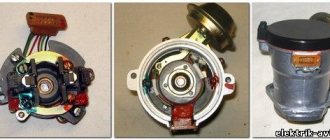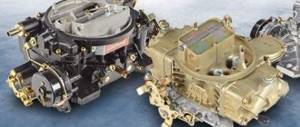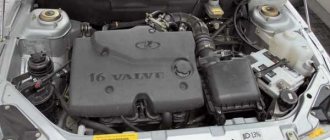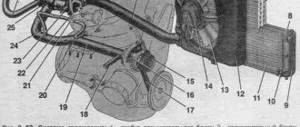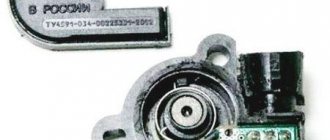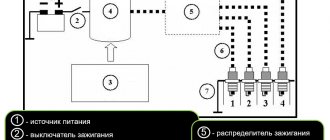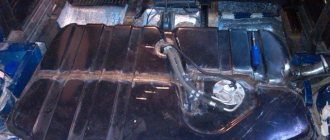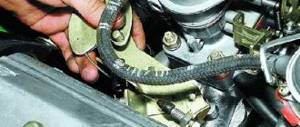Cars of the tenth family VAZ 2110-2112 became a logical continuation of the VAZ baroque - front-wheel drive cars of the eighth and ninth models. They also inherited the engine with all the attachments, and dozens of them still had old carburetor engines installed, which were later replaced by injection engines. With all its pros and cons, the car was in trend for some time, and later moved into the category of utilitarian transport.
In the photo VAZ 2110 is a logical continuation of the baroque VAZ
However, this did not make it any easier, and there were no fewer breakdowns. And there are no fewer fans of improving the designs of older cars. The exhaust system most often falls under repair or tuning, since it also fails quite often. It does not have a specific resource, since the quality of the components from which the exhaust system is assembled is completely different.
This is why many decide to take matters into their own hands, since buying a used ten means being prepared for anything. And the exhaust gas system can bring surprises at the most inopportune moment. To be ready to enter the battle for a silent exhaust or, conversely, a tuned noble sound, you need to at least know the hardware. Now let’s try to understand the design of the VAZ 2110 exhaust system and find out what to expect from it if it hasn’t smelled like factory paint for five years now.
Video tutorial on how to make an exhaust system
An exhaust manifold
The exhaust manifold is attached to the cylinder head directly with studs through a heat-resistant reinforced gasket. It is made of heat-resistant cast iron according to scheme 4-2. The collector is constantly subject to alterations from tuning studios, which replace the factory circuit with a wide variety of configurations and mounting options. It must be said that replacing the standard circuit, and especially replacing cast iron with steel, cannot bring anything good to the car.
The exhaust manifold is made of heat-resistant cast iron
Unless you are designing a narrow-profile car for competition. Moreover, for each discipline of motor sports, the exhaust manifold is configured separately and has some nuances in the design, which 90% of tuning studios have no idea about. Especially their customers. In most cases, the main focus is on the appearance of the pipe, but how it will work there is, by and large, all the same.
It must be said that the exhaust manifold is a rather important part and making it from steel, even the most heat-resistant, is a very questionable undertaking if the car will be used under normal conditions, and not just on the track or in rally raids. The collector temperature in operating mode can reach 1000 degrees. The cast iron is there for good reason and not at all to weigh down the engine structure. Any steel will burn out quite quickly under high load conditions, so before you buy an upgraded exhaust manifold made of super-Japanese steel, it would be worth thinking about the feasibility of such a replacement. Most of the top ten, thank God, do not participate in the world circuit racing championships; they simply have nothing to do there. Therefore, it would be more logical to correlate the rather modest capabilities of the VAZ 2110 engine with the level and quality of exhaust system tuning.
The exhaust manifold lasts almost forever and burns out in rare cases, and then due to a manufacturing defect. As part of improving the manifold with more effective methods, we would recommend that instead of installing thin-walled beautiful pipes of space configurations, simply pay attention to the mating of the exhaust ports of the cylinder head and the manifold holes. The fact is that the whole essence of tuning the exhaust system comes down, of course, to an amazing increase in power by reducing the resistance to exhaust gases. So it is precisely at this interface that the first additional power losses occur - at the junction of the manifold and the cylinder head. If the exhaust window and the manifold opening have even the slightest difference in size or level, parasitic vortices are formed that prevent the exhaust gases from escaping. If this is the case, after the collector you can even hang platinum direct flows with Swarovski diamonds, there will be no sense. If we are, of course, talking about saving power.
Replacing the exhaust pipe of a VAZ 2110 Lada muffler
- Repair manuals
- Repair manual for VAZ 2110 (Lada) 1996+.
- Replacing the exhaust muffler pipe
2.16.5. Replacing the exhaust muffler pipe
| EXECUTION ORDER |
↓ Comments ↓1. General information 1.0 General information 1.1. Vehicle Specifications 2. Engine 2.0 Engine 2.1 Possible engine malfunctions. 2.2 Replacing the coolant 2.3 Replacing the engine oil and oil filter 2.4. Installing the piston of the first cylinder to the TDC position of the compression stroke 2.5 Replacing the camshaft drive belt and tension roller 2.6 Adjusting the camshaft drive belt tension 2.7 Removing, troubleshooting and installing the flywheel 2.8. Replacing engine seal parts 2.9 Cylinder head 2.10 Grinding in valves 2.11 Adjusting clearances in valve drive 2.12 Removing and installing engine 2.13. Engine repair 2.14. Lubrication system 2.15. Cooling system 2.16. Exhaust gas system 2.18. Features of VAZ-2112 engine repair 3. Transmission 3.0 Transmission 3.1. Clutch 3.2. Gearbox 3.3. Front wheel drives 4. Chassis 4.0 Chassis 4.1. Checking the technical condition of suspension parts on the car 4.2. Rear suspension 5. Steering 5.0 Steering 5.1 Inspection and check of the steering on the vehicle 5.2. Steering column 5.4. Steering mechanism 5.5 Possible steering malfunctions. 6. Brake system 6.0 Brake system 6.1. Vacuum booster 6.2. Main brake cylinder 6.3. Pressure regulator 6.4. Brake hoses and tubes 6.5 Bleeding the brake system 6.6 Replacing brake fluid 6.7. Front wheel brakes 6.8. Braking mechanisms of the rear wheels 6.9. Parking brake 6.10 Possible malfunctions of the brake system. 7. Electrical equipment 7.0 Electrical equipment 7.1. Mounting block 7.2. Generator 7.3. Starter 7.4. Ignition switch (lock) 7.5. Checking and replacing spark plugs 7.6. Integrated engine management system (fuel injection system) 7.7. Contactless ignition system 7.8. Lighting, light and sound signaling 7.9. Windshield wiper 7.10 Replacing the electric motor of the radiator fan of the cooling system 7.11. Heater electric motor 7.12. Cigarette lighter 7.13. Instrument cluster 7.14 Checking the carburetor solenoid valve control unit 7.15 Possible malfunctions of the EPHH control unit. 7.16 Electrical diagram of a VAZ-21102 car 7.17 Electrical diagram of a car with a carburetor engine 2110 7.18 Engine control diagram 2111 (pin M1.5.4) 7.19 Engine control diagram 2111 (pin MP7.0) 7.20 Control diagram for engines 2111 and 2112 (pin M1) .5.4N, "January-5.1") 8. Body 8.0 Body 8.1 Possible body malfunctions. 8.2. Replacing the buffers 8.3 Removing and installing the radiator trim 8.4 Removing and installing the locker 8.5 Removing and installing the wing 8.6. Hood 8.7 Removing and installing upholstery, trim and windshield frame lining 8.8. Trunk lid 8.9. Side doors 8.10 Removing and installing the front seat 8.11 Removing and installing the upper and lower lining of the floor tunnel 8.12. Seat belts 8.13. Rear view mirrors 8.14. Instrument panel 8.15. Heater 8.16 Anti-corrosion compounds for body treatment 8.17. Features of body repair of models 2111 and 2112 8.18. Body care 9. Applications 9.0 Appendices 9.1 Fuels, lubricants and operating fluids 9.2 Basic data for adjustments and control 9.3 Filling volumes 9.4 Lamps used in the car |
Downpipe, catalytic converter and resonator
The downpipe is painted with heat-resistant paint to prevent corrosion
Next in the exhaust diagram is the exhaust pipe. In carburetor engines it is just a pipe, but in injection engines a terrible part is integrated into it - a catalytic converter. The exhaust pipe on stock tens is attached to the exhaust manifold through a flange, a heat-resistant reinforced gasket using four or six bolts. The connection between the exhaust pipe and the catalyst is made in the form of a corrugated nozzle with a ferrule. The pipe must be made of heat-resistant steel of a certain grade, and in most cases this is the case on conveyor vehicles. If the car is more than ten years old, most likely the middle part has already been replaced, so you can only guess about the quality of the steel from which it is made.
Ideally, a steel pipe is painted with heat-resistant protective paint to prevent inevitable corrosion at least for a while. Often, the paint on pipes that come in spare parts kits is more decorative than protective. Therefore, when replacing, many people tend to install a stainless steel pipe. There is no point in changing its diameter, and stainless steel will extend the life of the part quite significantly. If it is easier with carburetor engines, then in later engines with an injection system you need to take into account the catalyst, which is worth saying a few words about separately.
Catalysts began to be installed not to make life more difficult for motorists, but to reduce the level of harmful components in exhaust gases. The main task of a working catalyst is to burn fuel that did not burn during engine operation. By and large, it is designed in the same way as any resonator type muffler. The gases pass through a fine mesh or set of plates on which a thin layer of platinum-containing substance is deposited. By reacting with the exhaust gas, the surface of the working parts of the catalyst heats up to a temperature of 500-600 degrees, helping to ensure that the remaining fuel burns out as it passes through it. The average response threshold of catalytic plates or grids is 300°C.
And here the most uninteresting part begins. The catalytic layer of the device cannot process an endless amount of unburned fuel, bringing it to Euro standards. Therefore, to control the situation, an oxygen sensor was installed on the exhaust. The lambda probe measures the amount of oxygen in the exhaust gases, and if the catalyst is not able to process the required amount of gases, the probe sends a signal to the electronic control unit. The ECU, in turn, adjusts the composition of the mixture so that the amount of CO output corresponds to the norm.
When replacing the exhaust pipe, it is better to use a stainless steel spare part.
But this correction does not always benefit the dynamic performance of the engine. More precisely, it prevents the motor from working correctly. If the catalytic layer is completely burnt out, the lambda probe shouts “guard”, and the ECU turns on the “Check Engine” light. In this case, it is necessary to replace the catalyst completely, since it is a non-separable unit and cannot be repaired. It costs as much as the entire exhaust system combined.
Installing a new exhaust pipe
All work is done in reverse order. But there are several features that you definitely need to know:
- Install a new exhaust pipe.
- A new gasket needs to be installed between the exhaust manifold and the pants.
- Be sure to install a new O-ring between the neutralizer and the pants.
- Tighten the nuts on the exhaust manifold studs. Tighten them evenly in a crisscross pattern.
- Tighten the bolts that are on the spring-loaded connection to the converter.
This completes the repair of the exhaust system. The sound will be muffled as much as possible, the car will become almost silent. It is advisable to lubricate the new gasket with a CV joint type compound. This will improve the seal.
The work of replacing the muffler on a VAZ-2112 is not a systematic and periodic work, but is carried out only when this element fails. Noise, disconnection, burnout of its elements are the best example of this.
Video on replacing the muffler on a VAZ-2112 in a garage, do it yourself, watch:
In order to independently replace any of the muffler parts, you do not need special skills. All you need to do is strictly follow our instructions.
Typical malfunctions of the VAZ 2110 exhaust system
The VAZ 2110 muffler was configured in factory and laboratory conditions so as to suppress the maximum amount of noise that the engine produces. In this case, not only the frequencies emitted by the engine itself are taken into account. A car body is a closed volume that responds to a certain frequency of a sound wave and has its own peak harmonics. As a result of research, it was found that to suppress most of the parasitic frequencies of the 2110 engine and its body, it is necessary to use the range from 60 to 400 Hz. This corresponds to medium and high engine speeds - 2500 and 4200 rpm. If at least some changes are made to the geometry of the 2110 muffler compared to the stock one, the noise characteristics will definitely change.
Moreover, the main low-frequency noise is the most difficult to remove. Therefore, if we talk about combating noise and tuning the exhaust system at the same time, then technically it is almost impossible to implement this. The maximum retained power is direct flow, and the most comfortable sound is a factory muffler. All other options are compromises.
Burnouts, breakdowns and violation of system tightness are the main malfunctions that VAZ 2110 owners encounter. Most often, the cause of exhaust pipe burnout is corrosion, too rich a mixture and incorrectly set ignition. Smoke from the muffler may indicate that the mixture is too rich and is burning out in the exhaust pipe or resonator. In this case, the muffler often fires, popping noises are heard, as a result of which the resonators and mufflers burn out. A knock on the body in the area of the resonator or muffler may indicate that, as a result of mechanical damage, the geometry of the muffler has changed, the suspension, cushion or damper rubber has collapsed, and the pipe is knocking on the body. In this case, you need to accurately determine the location of the impacts and put the geometry of the system in order. If this is impossible to achieve due to the dilapidation of the elements, only replacement or strong repairs will solve this problem.
To repair mufflers, you can buy hundreds of types of sealants, bandages and thermal putties that will temporarily insulate damaged areas even without welding. Their quality is different, as is their price, but if the question is to make it through the season, then this restoration option has a right to life.
